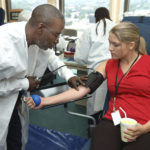The Specialist Who Is Trained to Draw Blood

Phlebotomists collect blood for donation or for testing, so the blood can be analyzed in a clinical laboratory. Blood tests are used to diagnose illness, evaluate the effectiveness of medications and determine whether a patient is receiving proper nutrition.
To collect blood from an arm vein, the phlebotomist first introduces himself/herself to the patient, properly identify the patient, wash their hands, put on gloves, applies a tourniquet to the upper arm to slow blood flow. An alcohol swab is used to disinfect a small area near the inside of the elbow. The phlebotomist then locates a vein and inserts a needle, release tourniquet before removing the needle, after removing the needle, dispose of needle immediately in a biohazard container. This process is called "venipuncture." The Phlebotomist must wash their hands after removing gloves. Phlebotomists can also sample blood through skin puncture, such as pricking a finger to test a patient's blood sugar or determine blood type.
The phlebotomist must ensure that all equipment is properly sanitized before it is used to collect blood. Accurate labeling, proper storage and careful transport are also key responsibilities.
Misidentification or contamination of a blood sample can have serious consequences because medical professionals rely on blood test results to diagnose patients and monitor treatment progress.
The phlebotomist also must observe strict safety protocols to avoid direct contact with the blood. Many infectious diseases, including HIV and hepatitis, can be transmitted through blood contact. Even the slightest distraction can lead to a "needlestick" injury and possible infection.
Working Conditions
Phlebotomists work in clinical laboratories, hospitals, community health centers, nursing homes, doctor's offices, blood donation centers and other health care facilities. They are usually supervised by a clinical laboratory technologist or other medical professional.
Phlebotomists must be extremely accurate and careful. In a busy facility, they may take dozens of blood samples during a typical shift. They must be able to work under pressure without sacrificing accuracy or safety.
Many patients are afraid of needles, so the first job of the phlebotomist is to put the patient at ease. Phlebotomists must be able to handle difficult, emotional and even angry patients.
Fine motor skills are needed to successfully insert a needle into a vein. Phlebotomists also must be well-organized, with extremely good attention to detail.
Salary Range and Outlook
Phlebotomists are paid hourly. Wages vary depending on the phlebotomist's location, shift, education and experience. The average phlebotomist earns $25,177 to $30,470 a year.
Academic Requirements
To become a phlebotomist, you must finish high school and complete a training program. The training program includes study in anatomy, blood collection procedures, proper storage and handling of blood samples and safety precautions. There are more than 200 accredited phlebotomy training programs at community colleges and vocational schools nationwide.
Many employers will hire only phlebotomists who have successfully passed the certification exam. To take the exam, you must complete a training program and demonstrate 100 successful venipunctures and 25 skin punctures.
The National Phlebotomy Association requires 200 hours of training, which includes clinical experience. Students also must pass the national certification exam with a score of 70% or better. Continuing education is required to maintain certification.
Some states also require phlebotomists to be licensed.
Learn More About a Career as a Phlebotomist
- Watch a video profile of phlebotomists (look for the profile in the Health Science category).
Resources
- National Phlebotomy Association
The National Phlebotomy Association reviewed this career profile.
The Specialist Who Is Trained to Draw Blood
Source: https://explorehealthcareers.org/career/allied-health-professions/phlebotomist/
0 Response to "The Specialist Who Is Trained to Draw Blood"
Post a Comment